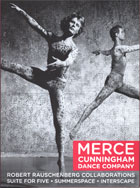
Merce Cunningham Dance Company, Robert Rauschenberg Collaborations: Suite for Five, Summerspace, Interscape 2010
Distributed by Microcinema International/Microcinema DVD, 2169 Folsom Street, Suite M101, San Francisco, CA 94110; 415-447-9750
Produced by Cunningham Dance Foundation and ARTPIX
Directed by Charles Atlas
DVD , color, 3 discs, 95 min. total (25:58 ; 22:05 ; 47:05)
Jr. High - Adult
Dance
Date Entered: 04/07/2011
Reviewed by Jessica Isler, Reference and Instruction Librarian, Middlebury College, Middlebury, VTThe three dances documented here offer glimpses into the fruitful collaboration between Merce Cunningham and Robert Rauschenberg, and also John Cage, three formidable American artists in their respective fields of dance, visual art, and music.
Suite for Five, first created in 1956 and filmed here in its 2003 revival features minimalist setting (aside from costumes featuring bright monochromatic hues) and the sparse Music for Piano 4-19 by John Cage. The simplicity of both the sonic and visual settings affords the audience unhindered consideration of Cunningham’s choreography for five bodies in motion, with action alternating between solo and group phrases, and culminating in a quintet. Atlas’ filming is similarly simple until the entrance of the quintet, when the stage is presented in split screen, allowing for simultaneous viewing of the solo and duet movements alongside that of the ensemble.
Filmed in 1999, Summerspace (1958) features a music box-like piano score by Morton Feldman (Ixion) and colorful, yet unobtrusive pointillist backdrop with matching costumes. The complete scene conjures a field of wind-blown wildflowers and seedpods as the dancers are swayed and scattered, yet ever terrestrially bounded. For this work and the next Atlas avoids the split screen and limits the camera work to close-ups of individual dancers and overall movement on the stage.
The most recent work presented here, Interscape (2000) represents a document of mature and dynamic artistic collaboration. Rauschenberg’s large-scale mural Interscape Mirage features images mundane and otherworldly, ranging from horse, temple, and duck, to a moon and other architectural and landscape elements. The dancers’ costumes are unified but unique, borrowing elements of color and composition from the mural. Cage’s shadowy score for solo cello One8 intermingles with the squeaks and shuffle of moving feet as the dance unfolds in a variety of long solo and group phrases. Interscape also presents the longest of the three dances in this set, featuring the work of thirteen different dancers over the course of its forty-five minute duration.
Each disc focuses solely on the performance, without commentary, interview, or other archival documentation. For information about the historical context, look to the accompanying booklet which contains a substantive essay by dance professor Bonnie Brooks, and archival photos of Cunningham and other dancers from the two original 1950s works.
Individually these pieces stand as visually and sonically engaging objects of contemporary art. As a whole, the package offers wonderful possibilities to reflect on the progression of collaboration between the creators, and the resulting artworks presented here. This DVD set is highly recommended for dancers, artists, musicians, and for anyone with an interest in the intersection of contemporary avant-garde music, pop art, and modern dance.